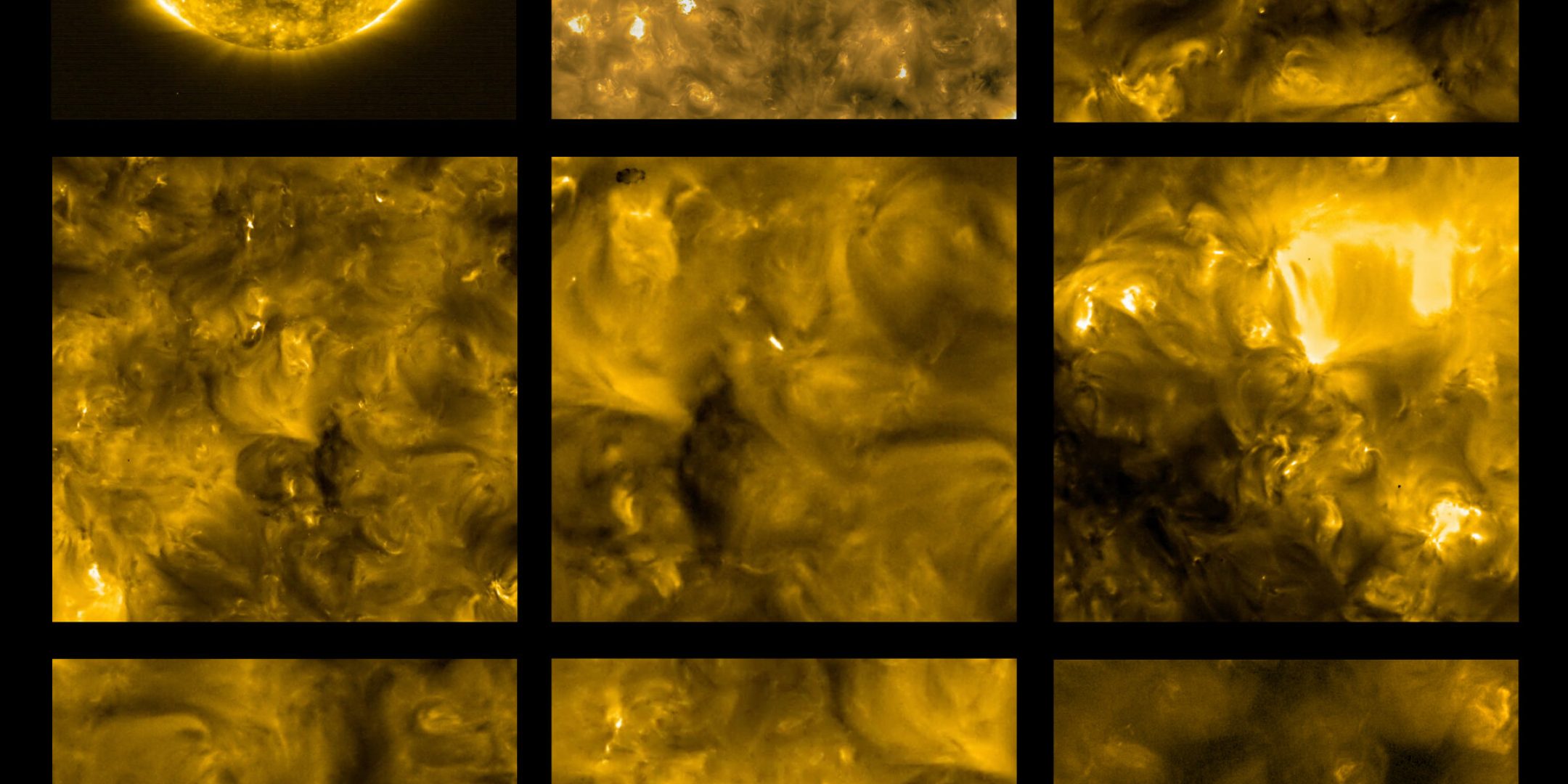Despite the setbacks the mission teams had to contend with during commissioning of the probe and its instruments in the midst of the COVID-19 pandemic, the first images received are outstanding.
The Sun has never been imaged this close up before. During its first perihelion, the point in the spacecraft’s elliptical orbit closest to the Sun, Solar Orbiter got to within 77 million kilometres of the star’s surface, about half the distance between the Sun and Earth. The spacecraft will eventually make much closer approaches; it is now in its cruise phase, gradually adjusting its orbit around the Sun. Once in its science phase, which will commence in late 2021, the spacecraft will get as close as 42 million kilometres, closer than the planet Mercury. The spacecraft’s operators will gradually tilt its orbit to get the first proper view of the Sun’s poles.
Solar Orbiter first images here
Launched during the night of 9 to 10 February, Solar Orbiter is on its way to the Sun on a voyage that will take a little over two years and a science mission scheduled to last between five and nine years. Dedicated to advancing solar and heliospheric physics, this ESA mission with a strong contribution from NASA aims to probe the solar wind and gain new insights into the Sun’s activity. Solar Orbiter will thus enable scientists to better characterize solar eruptive phenomena and understand how our star controls its environment and the interplanetary magnetic medium, otherwise known as the heliosphere. France has contributed its renowned scientific expertise to the mission through https://fscience-old.originis.fr/wp-content/uploads/2023/06/GLOC_Oslo_Norway_S2_27juillet2022_web-2-1.jpg, the national scientific research centre CNRS and CEA, the French atomic energy and alternative energies commission, helping to develop six of the ten instruments making up the spacecraft’s payload.
During the in-orbit commissioning phase, the instruments and subassemblies developed by the French scientific community all worked according to plan. https://fscience-old.originis.fr/wp-content/uploads/2023/06/GLOC_Oslo_Norway_S2_27juillet2022_web-2-1.jpg has overall responsibility for the French contribution, developed in partnership with research laboratories at CNRS, CEA, the Paris Observatory-PSL, universities and engineering schools.
- RPW (Radio and Plasma Waves): designed at the LESIA1 space and astrophysics instrumentation research laboratory, the RPW instrument will measure magnetic and electric fields at high temporal resolution to determine the characteristics of electromagnetic and electrostatic waves in the solar wind. CNRS research director Milan Maksimovic is the instrument’s principal investigator. The instrument, built at https://fscience-old.originis.fr/wp-content/uploads/2023/06/GLOC_Oslo_Norway_S2_27juillet2022_web-2-1.jpg, comprises three subassemblies:
- The Main Electronics Box (MEB), supplied by LESIA, incorporating a Low Frequency Receiver (LFR) designed and built by the LPP2 plasma physics laboratory and a High Frequency Receiver (HFR) designed and built by LESIA. These two receivers will process electromagnetic wave measurements on board the spacecraft;
- LESIA is also in charge of RPW instrument operations;
- The electric antennas procured by https://fscience-old.originis.fr/wp-content/uploads/2023/06/GLOC_Oslo_Norway_S2_27juillet2022_web-2-1.jpg from Heliospace Corporation (USA);
- The Search Coil Magnetometer (SCM), supplied by the LPC2E3 environmental and space physics and chemistry laboratory;
- SPICE (SPectral Imaging of the Coronal Environment): the IAS)4 space astrophysics institute is in charge of operations for the SPICE spectrograph that will measure the density, temperature, velocity and chemical composition of plasma in the solar atmosphere. The science lead is Frédéric Auchère, a researcher at Paris-Saclay University. IAS also supplied the instrument’s diffraction grating;
- SWA (Solar Wind Analyser), for which CNRS research director Philippe Louarn at the IRAP)5 astrophysics and planetology institute is co-principal investigator, will fully characterize the main components of solar wind plasma using three sensors to detect protons, electrons and ions:
- PAS (Proton-Alpha Sensor), designed and built entirely at IRAP, in charge of operations;
- EAS (Electron Analyser System), for which the electron-sensing system was designed and built by LPP;
- HIS (Heavy Ion Sensor), for which the sensing head was designed and built by IRAP;
- EUI (Extreme Ultraviolet Imager) will acquire image sequences of layers of the solar atmosphere from the photosphere to the corona. Co-principal investigator Frédéric Auchère at IAS designed the wide-field channel and is responsible for its calibration. IAS also built the optics and filter wheels in collaboration with IOGS (Institut d’Optique Graduate School);
- PHI (Polarimetric and Helioseismic Imager) will measure the Sun’s magnetic field and radial velocities at its surface, and probe its interior using time-distance helioseismology. Thierry Appourchaux at IAS is co-science lead for this instrument, for which he built the filtergraph and its high-voltage power supply;
- STIX (Spectrometer/Telescope for Imaging X-rays): teams at the IRFU research institute investigating the fundamental laws of the Universe at CEA, the French atomic energy and alternative energies commission, designed and built the detectors for the focal plane of the STIX instrument, which will provide X-ray images and spectra of solar flares.
Solar Orbiter is the first satellite to:
- Acquire images at high spatial resolution close to the Sun;
- Obtain images of the Sun’s poles thanks to its orbital inclination;
- Link in-situ measurements to solar phenomena observed with remote-sensing instruments;
- Solar Orbiter will also be able to observe the same region of the solar atmosphere for days at a time.
[1] LESIA : Observatoire de Paris-PSL/CNRS/ Sorbonne Université/Université de Paris
[2] LPP : Observatoire de Paris-PSL/CNRS/École polytechnique/Sorbonne Université/Université Paris-Saclay
[3] LPC2E : https://fscience-old.originis.fr/wp-content/uploads/2023/06/GLOC_Oslo_Norway_S2_27juillet2022_web-2-1.jpg/CNRS/Université d’Orléans
[4] IAS : CNRS/Université Paris-Saclay
[5] IRAP : Université Toulouse III – Paul Sabatier/CNRS/https://fscience-old.originis.fr/wp-content/uploads/2023/06/GLOC_Oslo_Norway_S2_27juillet2022_web-2-1.jpg








